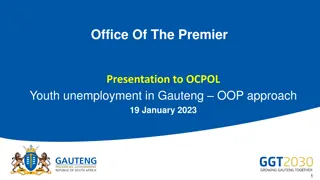Insights from Maine Integrated Youth Health Survey Data Analysis
The Maine Integrated Youth Health Survey (MIYHS) is a vital tool for understanding the health and habits of public school students. This comprehensive survey covers diverse topics like substance use, bullying, sexual health, physical activity, nutrition, and mental health. The presentation overview emphasizes the complexities of data analysis and provides examples of effective data utilization. Confidence intervals play a crucial role in interpreting survey results, ensuring statistical accuracy. Leveraging MIYHS data can support policy development, foster collaborations, secure funding, and raise community awareness. Understanding and applying statistical methods are key to unlocking the full potential of this valuable dataset.
Download Presentation

Please find below an Image/Link to download the presentation.
The content on the website is provided AS IS for your information and personal use only. It may not be sold, licensed, or shared on other websites without obtaining consent from the author.If you encounter any issues during the download, it is possible that the publisher has removed the file from their server.
You are allowed to download the files provided on this website for personal or commercial use, subject to the condition that they are used lawfully. All files are the property of their respective owners.
The content on the website is provided AS IS for your information and personal use only. It may not be sold, licensed, or shared on other websites without obtaining consent from the author.
E N D
Presentation Transcript
Using Maine Integrated Youth Health Survey Data Presentation Updated in 2024
MIYHS Background The Maine Integrated Youth Health Survey (MIYHS) is a comprehensive youth health survey administered in February of odd years. It is used to gauge the health and health habits of Maine s public school students. The survey covers the following topics: Alcohol, tobacco and drug use Bullying Sexual health Injury (intentional and unintentional) Physical activity and nutrition Mental health Protective factors (self confidence, perception, supports, assets) Grades
MIYHS Presentation Overview Data analysis can be a complex process especially with large survey instruments like the MIYHS. Presentation Content Using the MIYHS data Examples of effective ways to involve the data in your work Confidence Intervals: The term Confidence Interval is defined clearly and shown in two examples. Correlation vs. Causation Take Caution! other key analysis pointers Contact This presentation aims to simplify and define important strategies, terms and statistical methods needed to use the data effectively. 3
Applying the MIYHS data Some ways the MIYHS data can be used: Help support the need for a new or updated policy Start or continue conversations that will reveal opportunities for collaboration between partners (Engage partners on topics they care about) Open doors to work with new youth or parent groups Strengthen ability to apply for further funding (Use the data to determine and show the need) Start conversations about bringing evidence-based programs into schools Raise community awareness on local strengths and weaknesses such as: Create opportunities to dig deeper into the data with focus groups or group interviews about topics of interest. A town monthly newsletter that highlights events and opportunities.
Confidence Intervals: Defined Survey Year 2013 2015 17.3 (15.1-19.5) 15.5 (13.2-17.9) 12.7 (10.5-14.8) 14.2 (11.4-17.0) For all surveys, the reported percentage is an estimate & has some statistical error. This is error is accounted for by the Confidence Interval (C.I.): a range defined by: the Lower Confidence Limit (LCL) & the Upper Confidence Limit (UCL). If this survey was done 100 times, the results would fall within the LCL & the UCL 95 times. The 5 times the results fall outside of these ranges is due to random error; which cannot be completely eliminated. When comparing data for significant change , Confidence Intervals should always be used.
Confidence Intervals: Example No Significant Change Survey Question: During the past 30 days, on the days you smoked, how many cigarettes did you smoke per day? 2013 Showing HS Students who answered: 10 or more cigarettes per day 2015 Survey Year By comparing the Confidence Interval of this data point in 2013 and 2015; it can be seen that there is an overlap between the C.I s. 2013 2015 This means there is no statistically significant difference between the percent of high school students who reported smoking 10+ cigarettes per day in 2013 & the percentage in 2015. 17.3 (15.1-19.5) 15.5 (13.2-17.9) 12.7 (10.5-14.8) 14.2 (11.4-17.0)
Confidence Intervals: Example Significant Change Survey Question: During your life, how many days have you had at least one drink of alcohol? 2015 2013 2011 2009 Showing HS Students who answered: At least 1 day By comparing each Confidence Interval of this data point from: 2009, 2011, 2013, and 2015, it can be seen that there is no overlap between the C.I. s. This means there has been a statistically significant decrease in Maine high school students who reported drinking alcohol at least once since 2009.
Correlation Does Not Equal () Causation Correlation: When two or more things have some type of relationship. Causation: A relationship of cause and effect. A correlation between data points does not necessarily mean causation. Example: Of those students who reported receiving mostly D/Fs in 2013, 48% have also reported using alcohol in the past 30 days. While this data indicates a correlation between teen alcohol use & poor academic performance, it cannot be said that alcohol use causes poor academic performance. More information at: https://data.mainepublichealth.gov/miyhs/files/2013SpecialReports/GradesHealthfact.pdf
Take Caution! Things to watch for while using MIYHS Data Changes to the questions (i.e. Marijuana use regularly vs. 2-3 times a week ): Over time, the MIYHS has modified questions as needed to keep them accurate and relevant to changing brands, behaviors, substances, etc. Only compare questions not been marked as moderate or major modifications on the MIYHS Modified Variable Document to avoid comparing apples to oranges. (https://data.mainepublichealth.gov/miyhs/files/methodology/MIYHSModifiedVariables2015.pdf ) Do not use data from different surveys to evaluate change over time. Do not use data from different sources in the same study.
Questions? For any other information related to the MIYHS, Email: MIYHS.DHHS@maine.gov or go to: www.maine.gov/MIYHS 10























